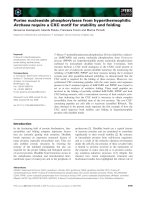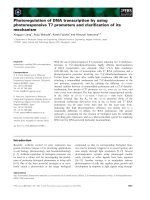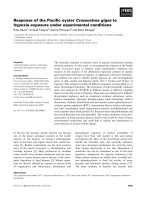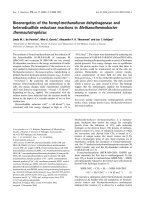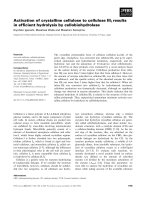Báo cáo khoa học: " Reproducibility of target volumes generated using uncoached 4-dimensional CT scans for peripheral lung cancer" pot
Bạn đang xem bản rút gọn của tài liệu. Xem và tải ngay bản đầy đủ của tài liệu tại đây (355.74 KB, 8 trang )
BioMed Central
Page 1 of 8
(page number not for citation purposes)
Radiation Oncology
Open Access
Research
Reproducibility of target volumes generated using uncoached
4-dimensional CT scans for peripheral lung cancer
Ylanga G van der Geld, Frank J Lagerwaard*, John R van Sörnsen de Koste,
Johan P Cuijpers, Ben J Slotman and Suresh Senan
Address: Department of Radiation Oncology, VU University medical center, Amsterdam, The Netherlands
Email: Ylanga G van der Geld - ; Frank J Lagerwaard* - ; John R van Sörnsen de
Koste - ; Johan P Cuijpers - ; Ben J Slotman - ;
Suresh Senan -
* Corresponding author
Abstract
Background: 4-dimensional CT (4DCT) scans are increasingly used to account for mobility during
radiotherapy planning. As variations in respiratory patterns can alter observed motion, with
consequent changes in the generated target volumes, we evaluated the reproducibility of 4D target
volumes generated during repeat uncoached quiet respiration.
Methods: A retrospective analysis was performed on two successive scans (4DCT1 and 4DCT2)
generated at the same scanning session for 26 patients with peripheral lung cancer treated with
stereotactic radiotherapy (SRT). The volume and position of planning target volumes (PTV
4DCT1
and PTV
4DCT2
) contoured on both scans were compared, and a dosimetric analysis performed. A
SRT plan optimized for each PTV was sequentially applied to the other PTV, and coverage by the
80% isodose was evaluated. Color intensity projections (CIP) were used to evaluate regions of
underdosage.
Results: No significant volumetric differences were observed between the two PTVs (t-Test p =
0.60). The average displacement of the center of mass between corresponding PTVs was 1.4 ± 1.0
mm, but differences in position were 2.0 mm or greater in 5 cases (19%). Coverage of both PTVs
by the 80% prescription isodose exceeded 90% for all but one patient. For the latter, the
prescription isodose covered only 82.5% of PTV
4DCT1
. CIP analysis revealed that the region of
underdosage was an end-inspiratory position occupied by the tumor for only 10–20% of the
respiratory cycle.
Conclusion: In nearly all patients with stage I lung cancer, the PTV derived from a single
uncoached 4DCT achieves dosimetric coverage that is similar to that achieved using two such
consecutive scans.
Background
Organ motion in the thorax confounds imaging, radio-
therapy treatment planning and treatment delivery for
patients with lung cancer [1]. When free breathing CT
scans are used for planning, variable geometric errors can
arise with respect to the position, shape, and the volume
Published: 01 November 2006
Radiation Oncology 2006, 1:43 doi:10.1186/1748-717X-1-43
Received: 19 September 2006
Accepted: 01 November 2006
This article is available from: />© 2006 van der Geld et al; licensee BioMed Central Ltd.
This is an Open Access article distributed under the terms of the Creative Commons Attribution License ( />),
which permits unrestricted use, distribution, and reproduction in any medium, provided the original work is properly cited.
Radiation Oncology 2006, 1:43 />Page 2 of 8
(page number not for citation purposes)
of the gross tumor volume (GTV) and mobile organs [2-
4]. With the use of 4-dimensional CT (4DCT), or respira-
tion-correlated CT scans, volumetric image data can be
acquired at many different respiratory states, and the
time-resolved 3D CT imaging allows organ motion to be
characterized for treatment planning [5-8]. A common
technique for 4DCT acquisition involves axial cine acqui-
sition with simultaneous recording of an external respira-
tory signal with over-sampled CT images, which are then
sorted into several bins based on the phase information
obtained from the respiratory signal [9]. 4DCT was found
to be superior to multiple conventional CT scans for gen-
erating internal target volumes (ITV) for stereotactic radi-
otherapy (SRT) of stage I non-small cell lung cancer
(NSCLC) [6].
However, the use of 4DCT scans does not remove all
mobility-induced artefacts. A study using phantoms
found that gated 4DCT acquisition reduced, but did not
eliminate volumetric errors when imaging moving objects
[3]. Another study reported residual volumetric differ-
ences between a static spherical object scanned helically
or with 4DCT while moving, to be within ± 5% [10]. In
patients, additional problems can arise if the respiratory
pattern is not sufficiently reproducible. This results in
missing images at a specific respiratory phase for some
table indices, leading to gaps in resorted 4DCT volumes
[10,11]. Breathing patterns in patients with lung cancer
can be complex and exhibit considerable diversity within
the same patient [12]. Routine breath coaching has been
proposed as a method to improve regular respiratory
motion during radiotherapy [5]. However, delivery of
fractionated SRT can take up to 40 minutes, which makes
coached respiration not feasible in patients who often
have severely compromised lung function. As respiration-
gated delivery at our center is only used for stage III
tumors, and not for SRT for small peripheral tumors, we
derived an ITV that was based upon all mobility observed
on two consecutive uncoached 4DCT scans.
The aim of the present study was to assess the reproduci-
bility of the two consecutive PTVs based upon uncoached
4DCT scans that were generated at a single imaging ses-
sion.
Methods
The successive planning 4DCT scans of 26 consecutive
patients with stage I NSCLC who were treated with SRT
were retrospectively analyzed.
4DCT scanning procedure
The 4DCT scanning approach used at our center has been
reported in detail previously [6-8]. Briefly, patients are
immobilized in the supine position with both arms posi-
tioned above the head on an adjustable arm support. The
Real-Time Position Management system (RPM, Varian
medical systems, Palo Alto, CA) uses a lightweight block
containing two reflective markers placed on the upper
abdomen to record the respiratory signal. 4DCT scans are
performed during uncoached quiet respiration on a 16
slice CT scanner (Lightspeed 16 GE Medical Systems,
Waukesha, WI). CT scanning commences when the RPM
system shows a regular respiratory pattern, and multiple
respiratory cycles are observed in order to determine the
adequate cine scan duration parameter.
For thoracic scans, 8 contiguous slices of 2.5 mm are gen-
erated for a 2 cm total longitudinal coverage per gantry
rotation with the scanner operated in axial cine mode.
Other scanning parameters include 140 KV, 95 mA and
tube rotation set closest to 1/10 of the average breathing
cycle time to allow high temporal and spatial resolution.
With the scanner couch in static mode, data is acquired for
at least the duration of one full respiratory cycle with the
addition of one second, after which the couch advances to
the next position. Data acquisition ceases during the
couch movement, and a full 4DCT scanning procedure of
the thorax generally takes about 90 seconds. The radiation
exposure from 4DCT acquisition is approximately 6 times
the dose from a single conventional helical CT scan [8]. As
variations in breathing patterns during uncoached CT
scans can lead to variations in the defined target volume,
our routine imaging protocol for SRT planning requires
that a second 4DCT scan (limited to the tumor region) be
performed directly after the first. The additional informa-
tion was considered crucial as doses of 60 Gy (to the 80%
isodose) were delivered in 3 fractions with no intra-frac-
tional imaging.
Advantage4D software (GE Medical Systems, Waukesha,
WI) is used to retrospectively sort the acquired images into
temporally coherent volumetric datasets. Each recon-
structed image is assigned to one of 10 respiratory phases
based on the temporal correlation between surface
motion of the lightweight block and data acquisition. For
each couch position, the reconstructed image with the res-
piratory phase nearest to the requested phase is selected to
form the 3D dataset for a given phase of the breathing
cycle. The user can define tolerance values for phase selec-
tion, and such phase tolerance is necessary in order to
obtain complete volumetric information as images at dif-
ferent couch positions are reconstructed at different respi-
ratory phase samples [10].
Generating Internal Target Volumes (ITVs)
The clinical SRT delivery for each patient was based on
non-gated treatment delivery to an ITV that was derived
from the summation of contouring on both 4DCT scans.
ITVs were generated using maximum intensity projection
(MIP) post-processing of data from each 4DCT scan in
Radiation Oncology 2006, 1:43 />Page 3 of 8
(page number not for citation purposes)
Advantage4D software. The MIP images reflect the maxi-
mum value of any given pixel intensity over all 10 phases
of the 4DCT scan, and contoured MIP images have been
shown to correspond well with ITVs derived from manual
contouring of the corresponding GTVs in all 10 phases of
a 4DCT [13].
A single end-expiratory phase of the 4DCT scan and both
MIP datasets were imported into the BrainLab stereotactic
planning system (Brainscan v 5.2, BrainLab AG, Heimstet-
ten, Germany), and both MIP scans were co-registered
with the single phase bin scan using the fusion software
tool in Brainscan. If necessary, adjustments were per-
formed to ensure a proper match of the spinal column.
The ITV was derived from contouring the tumor on both
MIP scans. A contour encompassing both ITV
4DCT
's was
used to derive the ITV for the clinical plan. An isotropic
ITV-PTV margin of 3 mm was added in order to account
for residual patient setup inaccuracies on the Novalis
Exactrac (Brainscan v 5.2, BrainLab AG, Heimstetten, Ger-
many), which uses an online patient setup verification
system. No separate margins were used to account for
microscopic tumor extension [14].
Retrospective comparison of PTVs
Two separate PTVs, namely PTV
4DCT1
and PTV
4DCT2
, were
generated and the volumes and location were compared.
For the latter, the displacement of the center of mass of
both PTVs in the X (medio-lateral), Y (anterior-posterior),
and Z (superior-inferior) direction was assessed using the
Brainlab coordinate system.
A dosimetric analysis was performed in order to evaluate
the clinical relevance of the variations between PTVs, if
present. The clinical treatment plan, which consisted of
between 8–12 non-coplanar treatment beams, was
sequentially modified by adjusting the beam portals to
both PTV
4DCT1
and PTV
4DCT2
. Stereotactic treatment plan-
ning was normalized to the 100% isodose at the isocenter.
As for the clinical treatment plan, PTV coverage by the
80% isodose was the goal of treatment planning. Cover-
age of the PTV
4DCT2
was evaluated using the plan devel-
oped for PTV
4DCT1
, followed by the reverse.
Color intensity projections (CIP)
In order to obtain temporal information in cases with sig-
nificant underdosage of the PTV based on a single 4DCT,
a composite color intensity projection (CIP) image of the
4DCT data was generated [15]. Briefly, the CIP technique
generates color images that represent a projection of the
intensity changes in the component images into a single
image. Pixels whose intensity changes over the phases of
the 4DCT appear in the CIP image as colored pixels, and
the hue encodes the percentage of time that tissue is
present in each location. CIP was implemented as a plug-
in tool to ImageJ that was written in-house. ImageJ (ver-
sion 1.31v) is a Java based image-processing package, and
is free public domain software [16].
Statistics
The Student paired t-test for comparison of volume of the
PTV
4DCT1
and PTV
4DCT2
was performed using Excel soft-
ware (Microsoft, Redmond, WA).
Results
Limited volumetric differences were observed between
PTV
4DCT1
and PTV
4DCT2
(Student t-test p = 0.60), with a
difference in volume exceeding 10% in 5 out of 26 cases
(19%). However, the differences were greater than 1 cc in
only 3 patients (12%). The average displacement of the
center of mass between the two PTVs was 1.4 ± 1.0 mm,
but the difference between the positions of the centers of
mass were 2.0 mm or greater in 5 cases (19%) (Table 1).
Dosimetric consequences
Treatment planning was performed using the 8–12 non-
coplanar beam setup arrangement used for the clinical
treatment of the patient. Beam portals were adjusted to
both PTV
4DCT1
and PTV
4DCT2
, respectively. When satisfac-
tory target coverage was obtained for PTV
4DCT1
, the mean
coverage of PTV
4DCT2
by the resulting 80% prescription
isodose was 97.8 ± 2.3%. Alternatively, the mean coverage
of PTV
4DCT1
was 97.0 ± 3.8% when planning was based on
coverage of PTV
4DCT2
(Table 2). The mean dose-volume
histogram of PTV coverage in all 26 patients is shown in
Figure 1. In all but one patient, the 80% prescription isod-
ose covered >90% of the PTV
4DCT
(Figure 2). In this latter
patient (no. 13), only 82.5% of PTV
4DCT1
was covered
when the plan was based upon PTV
4DCT2
. The shift
between the center of mass of both 4DCT scans was 3.7
mm in this patient, with a 19% volume difference
between both PTV's
4DCT
(Figure 2). The left panel of Figure
2 illustrates the inadequate coverage of the PTV
4DCT1
, and
the encompassing 20% isodose suggests a major under-
dosage at the lower border of the PTV
4DCT1
. The CIP image
that was generated from the 4DCT
1
at the same level, how-
ever, illustrates that the inadequate PTV coverage was at an
end-inspiratory GTV position, occupied by the tumor for
only 10–20% of the respiratory cycle (Figure 2, right
panel).
Discussion
Individualized margins are required to account for mobil-
ity of lung tumors, as no reliable correlation exists
between tumor location and mobility [17]. With the use
of 4DCT, spatial and temporal information on tumor and
normal organ mobility is generated by synchronously
recording the respiratory waveform during imaging. The
4DCT process includes two steps, the first of which is the
acquisition of several CT images per couch position
Radiation Oncology 2006, 1:43 />Page 4 of 8
(page number not for citation purposes)
through the volume of interest, which is followed by
resorting of the acquired images into spatiotemporally
coherent data sets.
Various approaches for 4DCT acquisition have been
reported, one of which is a widely applied technique in
clinical practice that uses the axial cine mode [6,8,9]. This
approach has been shown to be fairly accurate in phan-
tom studies, but residual motion artifacts arise due to fac-
tors such as partial volume projection effects, phase
tolerance values for resorting, and irregularities in the
breathing pattern of patients [10]. A recent report sug-
gested that the 4DCT system used in our patients fails to
generate optimal data in approximately 30% of patients
due to image sorting errors [18]. Reasons cited for the lat-
ter include the fact that processing of respiratory traces
may not accurately reflect the respiratory phase, and that
the RPM-software excludes tracing from periods of irregu-
lar respiration and Advantage4D disregards the corre-
sponding images. However, with the generation of ITVs
using MIP datasets generated from all respiratory phases,
image sorting inaccuracies become irrelevant, and
remaining differences between 4DCT scans are therefore
due to either lacking images of extreme tumor positions as
in the described case, or due to breathing irregularities
during the CT scanning session.
In view of concerns about the reproducibility of target vol-
umes derived from uncoached 4DCT scans that were post-
processed using the RPM approach, PTV determination in
our patients who underwent 3–5 fractions of non-gated
curative SRT for lung cancer was based upon data from 2
successive planning 4DCT scans. This analysis of the
repeat 4DCT scans in 26 patients revealed that volumetric
and spatial differences in PTVs in excess of 10% and 2
mm, respectively, were observed in a fifth of patients.
Despite the use of highly conformal stereotactic treatment
planning using multiple treatment beams, potential vari-
ations in the breathing cycle between CT scanning ses-
sions translated into substantial dosimetric differences in
only a single patient. The discrepancy in target volumes
for this particular patient may be explained by the 4DCT
scanning technique used. We perform axial (cine) scans
with table increments of 2 cm, and Figure 3 shows the
reconstructed respiratory waveforms during image acqui-
sition at the level of tumor in both 4DCT scans. For this
Table 1: Volumetric and spatial comparison of PTV
4DCT1
and PTV
4DCT2
Pat. PTV
4DCT1
(cm
3
)PTV
4DCT2
(cm
3
)PTV
4DCT1
– PTV
4DCT2
(cm
3
)PTV
4DCT1
– PTV
4DCT2
(%) 3D center of mass
displacement (mm)
1 28.1 29.3 1.2 4.2 1.7
2 16.2 16.9 0.7 4.5 1.9
3 39.3 38.4 1.0 -2.5 3.2
4 3.5 4.1 0.6 15.6 1.1
5 20.8 21.2 0.5 2.2 2.0
6 3.0 3.3 0.3 11.3 1.2
7 30.5 29.1 1.5 -4.8 1.3
8 9.2 10.0 0.8 8.5 2.6
9 13.9 13.6 0.3 -1.9 0.4
10 29.6 30.3 0.7 2.4 0.8
11 19.7 21.0 1.3 6.7 0.7
12 67.0 68.3 1.3 1.9 0.8
13 13.5 10.9 2.6 -19.4 3.7
14 21.0 20.7 0.3 -1.3 0.6
15 23.0 21.5 1.5 -6.7 1.0
16 13.8 13.5 0.3 -2.0 0.5
17 22.9 25.3 2.4 10.5 1.3
18 63.0 57.8 5.2 -8.3 3.5
19 21.1 21.2 0.2 0.8 1.4
20 23.5 21.9 1.6 -6.8 0.4
21 15.8 16.0 0.3 1.6 1.2
22 26.2 24.5 1.8 -6.8 1.6
23 10.6 10.1 0.5 -4.3 1.2
24 15.6 17.4 1.8 11.8 1.7
25 63.1 64.1 1.0 1.5 0.3
26 45.7 44.9 0.8 -1.8 0.3
Mean ± SD 1.2 ± 1.1 cm
3
0.7 ± 7.6% 1.4 ± 1.0 mm
Radiation Oncology 2006, 1:43 />Page 5 of 8
(page number not for citation purposes)
small and mobile tumor, the 4DCT image reconstruction
was derived from images that were acquired at two con-
secutive couch positions as evidenced by the discontinu-
ous waveforms. Although the amplitude at the end-
expiration tumor position (most cranial) was similar in
both 4DCT scans (A), a larger difference in amplitude was
seen during imaging at the end-inspiration tumor posi-
Mean dose-volume histogram for PTV coverage in 26 patientsFigure 1
Mean dose-volume histogram for PTV coverage in 26 patients.
Table 2: Percentage of each PTV encompassed by the 80% prescription isodose in a plan optimized for the other PTV.
Pat. Coverage of PTV
4DCT2
with planning based on PTV
4DCT1
Coverage of PTV
4DCT1
with planning based on PTV
4DCT2
197.8 98.2
296.3 97.1
398.6 95.2
497.8 96.9
593.0 99.6
696.9 92.9
798.9 98.3
890.7 93.4
998.8 98.9
10 98.9 97.2
11 97.4 100
12 99.9 100
13 97.6 82.5
14 99.2 99.3
15 98.8 95.4
16 99.4 99.6
17 93.9 99.5
18 99.3 91.2
19 99.5 99.8
20 100 98.1
21 99.3 98.1
22 98.8 93.9
23 98.1 97.6
24 94.8 100
25 98.8 98.3
26 100 99.8
Mean ± SD 97.8 ± 2.3% 97.0 ± 3.8%
Radiation Oncology 2006, 1:43 />Page 6 of 8
(page number not for citation purposes)
Left panel: Coronal reconstruction of the end-expiration phase bin of patient 13, showing both PTV
4DCT1
(violet contour) and PTV
4DCT2
(pink contour)Figure 2
Left panel: Coronal reconstruction of the end-expiration phase bin of patient 13, showing both PTV
4DCT1
(violet contour) and
PTV
4DCT2
(pink contour). Colorwash displays of the 80%, 60% and 20% isodoses show the most caudal area of PTV
4DCT1
to lie
in the 20% isodose area. Right panel: A corresponding color intensity projection in the same patient with the color bar provid-
ing time-related positional information (white = 100% presence; blue = 90%; green = 50%; orange = 10%). This indicates that
the most caudal PTV region represents a site occupied by the tumor for 10–20% of the respiratory cycle.
Respiratory waveforms during image acquisition for both 4DCT scans at the level of tumor in patient 13Figure 3
Respiratory waveforms during image acquisition for both 4DCT scans at the level of tumor in patient 13. Images were recon-
structed from acquisitions at two consecutive couch positions (table increments of 2 cm) as evidenced by the discontinuous
waveforms. The RPM amplitude at the end-expiration tumor position was similar in both 4DCT scans (A), but a larger differ-
ence in respiratory amplitude was seen at the end-inspiratory tumor position (B).
Radiation Oncology 2006, 1:43 />Page 7 of 8
(page number not for citation purposes)
tion (most caudal), which explains the discrepancy in the
caudal border of both PTVs.
Although the absolute underdosage in the most caudal
part of the PTV for this fraction of radiation appeared to
be important, analysis using the CIP technique revealed
that this region of the tumor was present in the area of
underdosage for only 10–20% of the time. For the actual
stereotactic treatment of this patient, the variation in PTVs
was of no consequence as routine clinical plans were
based upon ITVs derived from both 4DCT scans. Further-
more, we perform repeat 4DCT scans during the course of
SRT [19].
Our results on the reproducibility of uncoached 4DCT
scans appear to be even more reassuring in the context of
conventionally fractionated 3D conformal radiotherapy.
The larger GTV to PTV margins, and certainly also the
much lower conformity index of a 3–4 field treatment
plan [20], indicates that the variations between ITVs from
uncoached 4DCT scans would not have a great impact.
Furthermore, previous analysis indicates that incorporat-
ing the extremes of respiration-induced tumor movement
during conventionally fractionated radiotherapy leads to
an overestimation of the PTV [21-24].
Respiratory coaching during 4DCT imaging and treatment
delivery has been advocated for patients undergoing gated
radiotherapy. This approach is, however, not feasible in
patients undergoing SRT as the delivery of a single fraction
of non-gated SRT can take more than 30–40 minutes. Fur-
thermore, it is doubtful if patients with medically inoper-
able stage I NSCLC who generally have severely impaired
lung function can tolerate prolonged periods of coached
breathing. We will study the variations in respiratory pat-
terns of patients during the delivery of uncoached SRT,
and interrupting treatment delivery when amplitude
changes in RPM exceed those observed during the 4DCT
scan may be one approach to ensure target reproducibil-
ity.
Conclusion
In the majority of patients with stage I lung cancer, the
PTV derived from a single uncoached 4DCT achieves sim-
ilar dosimetric coverage as is achieved using two consecu-
tive 4DCT scans. This indicates that the intra-fractional
reproducibility of uncoached 4DCT scans in this patient
group is sufficiently reliable in clinical plans based upon
target volumes that incorporate all mobility.
References
1. Senan S, Chapet O, Lagerwaard FJ, Ten Haken RK: Defining target
volumes for non-small cell lung carcinoma. Semin Radiat Oncol
2004, 14:308-314.
2. Balter JM, Ten Haken RK, Lawrence TS, Lam KL, Robertson JM:
Uncertainties in CT-based radiation therapy treatment
planning associated with patient breathing. Int J Radiat Oncol
Biol Phys 1996, 36:167-174.
3. Shen S, Duan J, Fiveash JB, Brezovich IA, Plant BA, Spencer SA, Popple
RA, Pareek PN, Bonner JA: Validation of target volume and
position in respiratory gated CT planning and treatment.
Med Phys 2003, 30:3196-3205.
4. Keall PJ, Starkschall G, Shukla H, Forster KM, Ortiz V, Stevens CW,
Vedam SS, George R, Guerrero T, Mohan R: Acquiring 4D tho-
racic CT scans using a multislice helical method. Phys Med Biol
2004, 49:2053-2067.
5. Vedam SS, Keall PJ, Kini VR, Mostafavi H, Shukla HP, Mohan R:
Acquiring a four-dimensional computed tomography data-
set using an external respiratory signal. Phys Med Biol 2003,
48:45-62.
6. Underberg RWM, Lagerwaard FJ, Cuijpers JP, Slotman BJ, van Sörnsen
de Koste JR, Senan S: Four-dimensional CT scans for treatment
planning in stereotactic radiotherapy for stage I lung cancer.
Int J Radiat Oncol Biol Phys 2004, 60:1283-1290.
7. Underberg RWM, Lagerwaard FJ, Slotman BJ, Cuijpers JP, Senan S:
Benefit of respiration-gated stereotactic radiotherapy for
stage I lung cancer: an analysis of 4DCT datasets. Int J Radiat
Oncol Biol Phys 2005, 62:554-560.
8. van Sörnsen de Koste JR, Senan S, Kleynen CE, Slotman BJ, Lager-
waard FJ: Renal mobility during uncoached quiet respiration:
An analysis of 4DCT scans. Int J Radiat Oncol Biol Phys 2006,
64:799-803.
9. Pan T, Lee TY, Rietzel E, Chen GT: 4D-CT imaging of a volume
influenced by respiratory motion on multi-slice CT. Med Phys
2004, 31:333-340.
10. Rietzel E, Pan T, Chen GT: Four-dimensional computed tomog-
raphy: image formation and clinical protocol. Med Phys 2005,
32:874-889.
11. Keall P: 4-dimensional computed tomography imaging and
treatment planning. Semin Radiat Oncol
2004, 14:81-90.
12. Ozhasoglu C, Murhpy MJ: Issues in respiratory motion compen-
sation during external-beam radiotherapy. Int J Radiat Oncol
Biol Phys 2002, 52:1389-1399.
13. Underberg RW, Lagerwaard FJ, Slotman BJ, Cuijpers JP, Senan S: Use
of maximum intensity projections (MIP) for target volume
generation in 4DCT scans for lung cancer. Int J Radiat Oncol Biol
Phys 2005, 63:253-260.
14. Potters L, Steinberg M, Rose C, Timmerman R, Ryu S, Hevezi JM,
Welsh J, Mehta M, Larson DA, Janjan NA: American Society for
Therapeutic Radiology and Oncology and American College
of Radiology practice guideline for the performance of ster-
eotactic body radiation therapy. Int J Radiat Oncol Biol Phys 2004,
60:1026-1032.
15. Cover KS, Lagerwaard FJ, Senan S: Color intensity projections: A
rapid approach for evaluating four-dimensional CT scans in
treatment planning. Int J Radiat Oncol Biol Phys 2006, 64:954-961.
16. ImageJ [ />]
17. van Sörnsen de Koste JR, Lagerwaard FJ, Nijssen-Visser MR, Grave-
land WJ, Senan S: Tumor location cannot predict the mobility
of lung tumors: a 3D analysis of data generated from multi-
ple CT scans. Int J Radiat Oncol Biol Phys 2003, 56:348-354.
18. Rietzel E, Chen GT: Improving retrospective sorting of 4D
computed tomography data. Med Phys 2006, 33:377-379.
19. Underberg RW, Lagerwaard FJ, van Tinteren H, Cuijpers JP, Slotman
BJ, Senan S: Time trends in target volumes for stage I non-
small-cell lung cancer after stereotactic radiotherapy. Int J
Radiat Oncol Biol Phys 2006, 64:1221-1228.
20. van Sörnsen de Koste JR, Lagerwaard FJ, Schucchard-Schipper RH,
Nijssen-Visser MR, Voet PW, Oei SS, Senan S: Dosimetric conse-
quences of tumor mobility in radiotherapy of stage I non-
small cell lung cancer – an analysis of data generated using
'slow' CT scans. Radioth Oncol 2001, 61:93-99.
21. Stroom JC, de Boer HC, Huizenga H, Visser AG: Inclusion of geo-
metrical uncertainties in radiotherapy treatment planning
by means of coverage probability. Int J Radiat Oncol Biol Phys
1999, 43:905-919.
22. Engelsman M, Damen EM, De Jaeger K, van Ingen KM, Mijnheer BJ:
The effect of breathing and set-up errors on the cumulative
dose to a lung tumor. Int J Radiat Oncol Biol Phys 2001, 60:95-105.
23. van Herk M, Witte M, van der Geer J, Schneider C, Lebesque JV: Bio-
logic and physical fractionation effects of random geometric
errors. Int J Radiat Oncol Biol Phys 2003, 57:1460-1471.
Publish with BioMed Central and every
scientist can read your work free of charge
"BioMed Central will be the most significant development for
disseminating the results of biomedical research in our lifetime."
Sir Paul Nurse, Cancer Research UK
Your research papers will be:
available free of charge to the entire biomedical community
peer reviewed and published immediately upon acceptance
cited in PubMed and archived on PubMed Central
yours — you keep the copyright
Submit your manuscript here:
/>BioMedcentral
Radiation Oncology 2006, 1:43 />Page 8 of 8
(page number not for citation purposes)
24. Engelsman M, Sharp GC, Bortfeld T, Onimaru R, Shirato H: How
much margin reduction is possible through gating or breath
hold? Phys Med Biol 2005, 50:477-490.




